Work and Machines
What is Work?
Work is done when a force is applied to an object and the object moves in the direction of the force.
Calculating Work
The formula for calculating work is:
Work (W) = Force (F) x Distance (d) x cos(θ)
Where θ is the angle between the force and the direction of motion.
Types of Simple Machines
There are six types of simple machines:
- Lever
- Wheel and Axle
- Pulley
- Inclined Plane
- Wedge
- Screw
How Machines Make Work Easier
Machines make work easier by changing the size or direction of a force or the distance over which a force is applied.
Calculating Mechanical Advantage
Mechanical Advantage (MA) is the ratio of the output force to the input force in a machine. It can be calculated using the formula:
MA = Output Force (OF) / Input Force (IF)
Examples of Work and Machines in Everyday Life
Examples of work and machines in everyday life include using a ramp to move heavy objects, using a pulley to lift a heavy load, and using a screw to hold objects together.
[Work And Machines] Related Worksheets and Study Guides:
.◂Science Worksheets and Study Guides Third Grade. Work and machines
Study Guide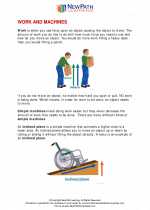 Work and machines
Work and machines  Activity Lesson
Activity Lesson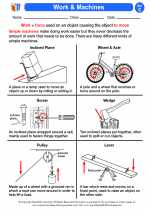 Work & Machines
Work & Machines  Worksheet/Answer key
Worksheet/Answer key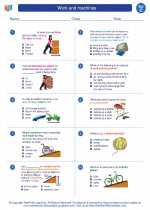 Work and machines
Work and machines  Worksheet/Answer key
Worksheet/Answer key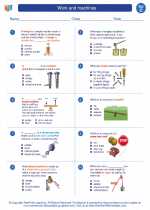 Work and machines
Work and machines  Worksheet/Answer key
Worksheet/Answer key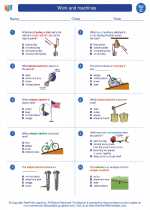 Work and machines
Work and machines  Worksheet/Answer key
Worksheet/Answer key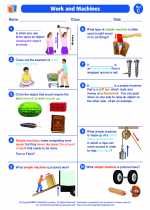 Work and machines
Work and machines  Vocabulary/Answer key
Vocabulary/Answer key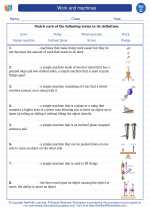 Work and machines
Work and machines 

 Activity Lesson
Activity Lesson
 Worksheet/Answer key
Worksheet/Answer key
 Worksheet/Answer key
Worksheet/Answer key
 Worksheet/Answer key
Worksheet/Answer key
 Worksheet/Answer key
Worksheet/Answer key
 Vocabulary/Answer key
Vocabulary/Answer key

The resources above cover the following skills:
Concepts of Physical Science (SB1, SB2, SB3, SB4)
The student demonstrates an understanding of motions, forces, their characteristics, relationships, and effects by recognizing that objects can be moved without being touched (e.g., using magnets, falling objects, static electricity).
Concepts of Physical Science: A student should understand and be able to apply the concepts, models, theories, universal principles, and facts that explain the physical world. A student who meets the content standard should:
Develop an understanding of motions, forces, their characteristics and relationships, and natural forces and their effects.